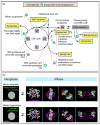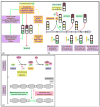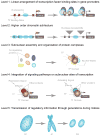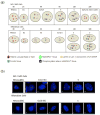The abbreviated pluripotent cell cycle
- PMID: 22552993
- PMCID: PMC3667593
- DOI: 10.1002/jcp.24104
The abbreviated pluripotent cell cycle
Abstract
Human embryonic stem cells (hESCs) and induced pluripotent stem cells proliferate rapidly and divide symmetrically producing equivalent progeny cells. In contrast, lineage committed cells acquire an extended symmetrical cell cycle. Self-renewal of tissue-specific stem cells is sustained by asymmetric cell division where one progeny cell remains a progenitor while the partner progeny cell exits the cell cycle and differentiates. There are three principal contexts for considering the operation and regulation of the pluripotent cell cycle: temporal, regulatory, and structural. The primary temporal context that the pluripotent self-renewal cell cycle of hESCs is a short G1 period without reducing periods of time allocated to S phase, G2, and mitosis. The rules that govern proliferation in hESCs remain to be comprehensively established. However, several lines of evidence suggest a key role for the naïve transcriptome of hESCs, which is competent to stringently regulate the embryonic stem cell (ESC) cell cycle. This supports the requirements of pluripotent cells to self-propagate while suppressing expression of genes that confer lineage commitment and/or tissue specificity. However, for the first time, we consider unique dimensions to the architectural organization and assembly of regulatory machinery for gene expression in nuclear microenviornments that define parameters of pluripotency. From both fundamental biological and clinical perspectives, understanding control of the abbreviated ESC cycle can provide options to coordinate control of proliferation versus differentiation. Wound healing, tissue engineering, and cell-based therapy to mitigate developmental aberrations illustrate applications that benefit from knowledge of the biology of the pluripotent cell cycle.
Copyright © 2012 Wiley Periodicals, Inc.
Conflict of interest statement
The authors have no conflicts of interest.
Figures






Similar articles
-
The architectural organization of human stem cell cycle regulatory machinery.Curr Pharm Des. 2012;18(13):1679-85. doi: 10.2174/138161212799859639. Curr Pharm Des. 2012. PMID: 22394165 Free PMC article. Review.
-
Cell cycle regulation in human embryonic stem cells: links to adaptation to cell culture.Exp Biol Med (Maywood). 2013 Mar;238(3):271-5. doi: 10.1177/1535370213480711. Exp Biol Med (Maywood). 2013. PMID: 23598972 Review.
-
Expression and functional analysis of G1 to S regulatory components reveals an important role for CDK2 in cell cycle regulation in human embryonic stem cells.Oncogene. 2009 Jan 8;28(1):20-30. doi: 10.1038/onc.2008.358. Epub 2008 Sep 22. Oncogene. 2009. PMID: 18806832
-
Regulation of cyclin E1 expression in human pluripotent stem cells and derived neural progeny.Cell Cycle. 2018;17(14):1721-1744. doi: 10.1080/15384101.2018.1496740. Epub 2018 Aug 10. Cell Cycle. 2018. PMID: 29995582 Free PMC article.
-
Human embryonic stem cells are pre-mitotically committed to self-renewal and acquire a lengthened G1 phase upon lineage programming.J Cell Physiol. 2010 Jan;222(1):103-10. doi: 10.1002/jcp.21925. J Cell Physiol. 2010. PMID: 19774559 Free PMC article.
Cited by
-
Mucin-Inspired Thermoresponsive Synthetic Hydrogels Induce Stasis in Human Pluripotent Stem Cells and Human Embryos.ACS Cent Sci. 2016 Feb 24;2(2):65-74. doi: 10.1021/acscentsci.5b00370. Epub 2016 Feb 10. ACS Cent Sci. 2016. PMID: 27163030 Free PMC article.
-
Radiation Response of Murine Embryonic Stem Cells.Cells. 2020 Jul 9;9(7):1650. doi: 10.3390/cells9071650. Cells. 2020. PMID: 32660081 Free PMC article.
-
RPLP1 Is Up-Regulated in Human Adenomyosis and Endometrial Adenocarcinoma Epithelial Cells and Is Essential for Cell Survival and Migration In Vitro.Int J Mol Sci. 2023 Jan 31;24(3):2690. doi: 10.3390/ijms24032690. Int J Mol Sci. 2023. PMID: 36769010 Free PMC article.
-
Human embryonic stem cells display a pronounced sensitivity to the cyclin dependent kinase inhibitor Roscovitine.BMC Mol Cell Biol. 2019 Aug 28;20(1):40. doi: 10.1186/s12860-019-0222-3. BMC Mol Cell Biol. 2019. PMID: 31462218 Free PMC article.
-
African Swine Fever Virus Manipulates the Cell Cycle of G0-Infected Cells to Access Cellular Nucleotides.Viruses. 2022 Jul 22;14(8):1593. doi: 10.3390/v14081593. Viruses. 2022. PMID: 35893659 Free PMC article.
References
-
- Adamo A, Sese B, Boue S, Castano J, Paramonov I, Barrero MJ, Izpisua Belmonte JC. LSD1 regulates the balance between self-renewal and differentiation in human embryonic stem cells. Nat Cell Biol. 2011;13:652–659. - PubMed
-
- Amente S, Bertoni A, Morano A, Lania L, Avvedimento EV, Majello B. LSD1-mediated demethylation of histone H3 lysine 4 triggers Myc-induced transcription. Oncogene. 2010a;29:3691–3702. - PubMed
-
- Amente S, Lania L, Avvedimento EV, Majello B. DNA oxidation drives Myc mediated transcription. Cell Cycle. 2010b;9:3002–3004. - PubMed
-
- Amit M, Carpenter MK, Inokuma MS, Chiu CP, Harris CP, Waknitz MA, Itskovitz-Eldor J, Thomson JA. Clonally derived human embryonic stem cell lines maintain pluripotency and proliferative potential for prolonged periods of culture. Dev Biol. 2000;227:271–278. - PubMed
Publication types
MeSH terms
Substances
Grants and funding
LinkOut - more resources
Full Text Sources

